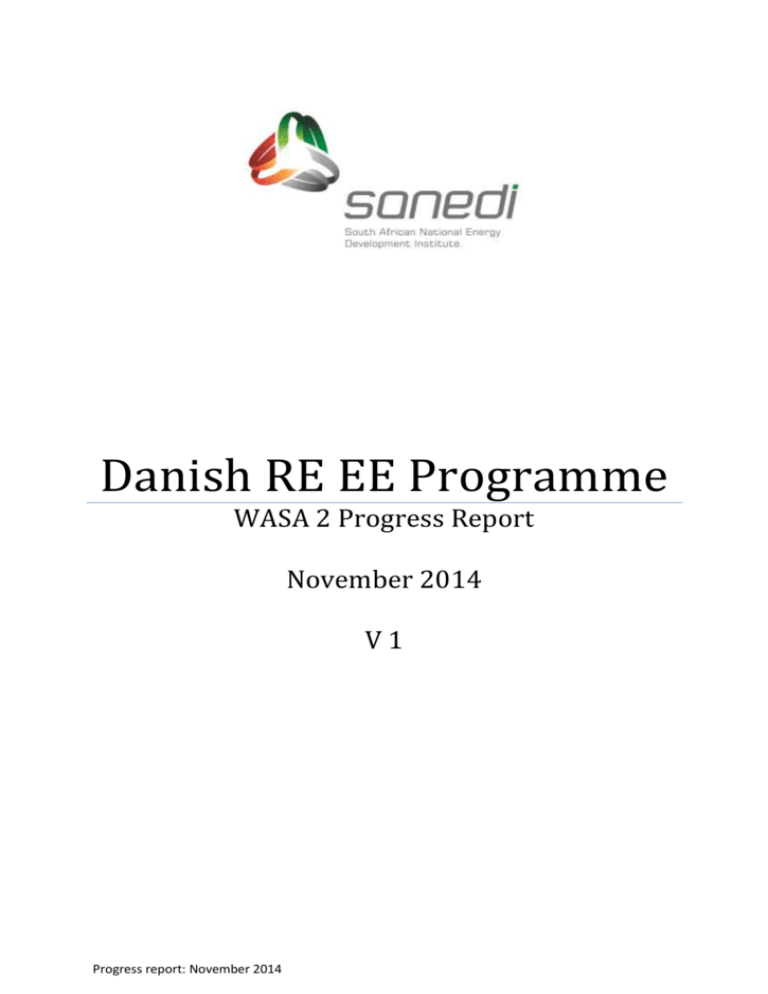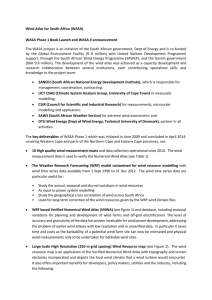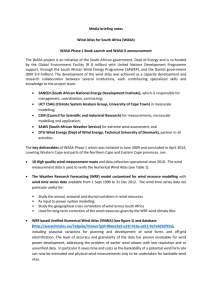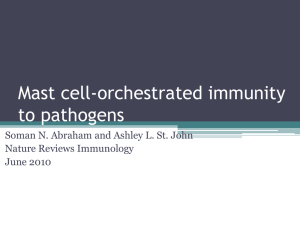ProgressReportv24112014
advertisement

Danish RE EE Programme WASA 2 Progress Report November 2014 V1 Progress report: November 2014 Table of Contents Component 2 WASA 2 ................................................................................................................................ 3 1. Work plan 2014/15 ................................................................................................................................. 3 2. Financial status ....................................................................................................................................... 3 3. Work Package progress .......................................................................................................................... 3 3.1 WP1 Mesoscale modelling (UCT, DTU) ................................................................................................. 3 3.2 WP2 Wind Measurements (CSIR) ......................................................................................................... 5 3.2.1 Renewal of WASA 1 Letters of Agreement ........................................................................................ 5 3.2.2 Site Selection ..................................................................................................................................... 5 Eastern Cape site WM11 ........................................................................................................................ 5 KwaZulu-Natal sites WM12 & WM13 .................................................................................................. 7 Free State sites - WM14 & WM15 ....................................................................................................... 10 3.2.3 Tender documents ........................................................................................................................... 12 3.3 WP3 Microscale modelling (CSIR, DTU) .............................................................................................. 14 3.4 Application (CSIR, DTU)....................................................................................................................... 14 3.5 WP5 Extreme Wind Atlas (SAWS, DTU) .............................................................................................. 14 3.6 WP 6 Documentation, Dissemination (SANEDI) ................................................................................. 18 4 Conclusion.............................................................................................................................................. 18 2 Component 2 WASA 2 1. Work plan 2014/15 Addendum A shows the 2014/15 work plan (total DKK2 464 270) with an indication of the partners expenditure (sections highlighted in yellow) for the period April 2014 to 31 August 2014, total DKK415 991 (R760 634.49). The expenditure will substantially increase once all the masts sites have been secured and the mast and instrumentation tenders awarded and contracts signed (hardware tender budget DKK2 748 227.11, see work package progress). 2. Financial status Paid to date 15% advance payment (DTU, SAWS, CSIR) R1 857 581.46 (DKK1 015 911.30) In progress UCT advance payment R276 548.82 (DKK151 244.55) Expected total WASA 2 payment by 31 March 2015: 15% advance payment, CSIR, DTU, SAWS, UCT R2 134 130.28 (DKK1 167 155.85) Estimated partners invoice (Dec 2014) R1 279 941.49 (DKK700 000) Total 31 March 2015 R3 414 071.77 (DKK 1 867 155.85) Tender R5 025 099.86 (DKK 2 748 227.11) Expected total WASA 2 payment by July 2015 R8 439 171.63 (DKK4 615 382.97) Received (June 2014) R7 146 019 3. Work Package progress 3.1 WP1 Mesoscale modelling (UCT, DTU) WP1 mesoscale modelling activities are dependent on and will commence with the start of the WP2 wind measurement activities. 3 WP22 have consulted with WP21 on potential siting of the measurement masts in terms of location and wind climate. In the former topography and land were considered. In the latter, a section of Brendan Argent’s PhD has developed climatological wind roses for stations across South Africa and these data were consulted as applicable. Student supervision at UCT is ongoing. Currently four students are funded or partially funded by the WASA 2 project. Details of the theses are below. Supervision is shared by DTU (Dr Andrea Hahman) and UCT (Dr Chris Lennard) with Dr Lennard the primary supervisor and first point of contact for each student. Tich Mukunga has indicated he would like to continue his studies through WASA2 to complete a M.Sc. in 2015-2016. Dr Lennard and two students (Teboho Nchaba and Tich Mukunga) met with the Danish Minister of Climate, Energy and building who was hosted by the Vice Chancellor of UCT, Dr Max Price. Both the Minister and the Vice Chancellor were impressed by the work being done by the WASA project and the students. Student Degree Expected graduation year Title Brendan Argent Ph.D. 2014 Towards an Uncertainty Atlas for Wind Forecasts in South Africa Teboho Nchaba Ph.D. 2017 Improved South African wind atlas from multi-model superensemble Zaccheus Oalefe Ph.D. 2017 Assessment of offshore wind resource on the west coast of South Africa Tich Mukunga B.Sc. (Hons) 2014 An evaluation of wind trends in three reanalyses over the Western Cape Activities for the next 5 months (November 2014 to March 2015) 1. Regional model setup at UCT and sensitivity studies commencement 2. Mesoscale and local scale process studies commencement 3. Development of ensemble-based numerical wind atlas methodology 4. Tich Mukunga to begin M.Sc. beginning 2015 4 5. Graduation of Tich Mukunga and hand in of PhD by Brendan Argent 3.2 WP2 Wind Measurements (CSIR) 3.2.1 Renewal of WASA 1 Letters of Agreement Letters of Agreement for the 9 WASA 1 masts to remain for another 3 years were signed by CSIR with the site owners of WM01, WM02, WM03, WM05, WM06, WM07, WM08, WM09. The approval of the Tribal Chief at WM10 still needs securing. Documents have to be couriered but the only address we could obtain for the Chief is a postal address, but courier companies don’t deliver to post boxes. Alternative arrangements are underway. 3.2.2 Site Selection (more detail in draft Site Selection Report, Addendum B) At a meeting in SANEDI on 11 April 2014 the first indications were developed of the general areas within which the five new WASA2 mast sites should preferably be located – based on the site selection criteria agreed upon. This allowed CSIR to try to locate suitable sites in these areas using Google Earth and 1:50000 topographical maps. The couple of potential sites per region were then sent to all WASA team partners for comments, and were eventually weeded down to a few. Eastern Cape site WM11 The original idea was to have a mast site close to the coast in the vicinity of Port Edward, but on the E/Cape side of the provincial border. Communications with the various District Regional Directors of the E/Cape Department of Economic Development, Environmental Affairs and Tourism, revealed however that this area falls within the Wild Coast Environmental Management area, which has a Coastal Corridor of 5 to 15km where no structure with visual impact should be erected, and if approval is given, the structure should be camouflaged. There are also two vulture colonies in the area, with their feeding grounds covering all the possible sites that were selected for this area. Any development, no matter how small, must be addressed through a full EIA as well as other authorization processes. . The agreement of the WASA team was that masts should be erected in areas which pose the least risk of having to undergo lengthy EIA processes, so it was decided by the WASA team that another area should be identified. In Skype discussions with DTU it was agreed to look for a site 5 in the vicinity of the town of Rhodes, in an area which DTU’s mesoscale map shows as having very high wind resources. Again a possible site was selected, ownership of the farms determined, and contact was made with the farm owner. However, the farms belong to a Trust, which had to be consulted before the green light was given to CSIR to visit the area together with the owner(s) to select a site. An initial expectation of theirs was what the possible advantages were for the Trust if they allow the mast to be erected on their property, as well as concern for the 10km of 4x4 vehicle track to the site that might be damaged by the mast contractors. The owners were assured that no compensation was paid to the WASA1 mast site landowners, nor would WASA2 mast site landowners be compensated, as this was a Government initiative. This seems to have been accepted. The latter concern of damage to the vehicle track would be addressed in the tender documents. The farm Cheviot was visited with the owner on the 30th of Sept. and the site demarcated and coordinates taken. A verbal agreement with the farm owner was concluded. Figure 1 The site of mast WM11 6 KwaZulu-Natal sites WM12 & WM13 With the shifting of the WM11 site to Rhodes, we were advised by DTU to, where possible, move the WM12 site to an area closer to the coast, SW of Durban. Should it prove difficult, we should revert back to the original WM12 site near Wartburg in the KZN midlands. An appropriate area on the R603 road near Eston was identified, ownerships established, and the area visited during the week of 29 Sep – 2 Oct. Unfortunately the owner of the farm we arranged to visit, informed us on the morning of the visit that he would not be able to meet with us due to other commitments. We then drove around to look for possible other sites, made contact with one owner, who gave us the contact details of another land owner who might have land available. As we had to rush back to the airport to catch our flight back home we could not visit this farmer. During a second trip to KZN (20- 23 Oct) we also visited an area near Scottburgh to look for a potential site, and then visited the farmer at Eston (whose details we got during the previous trip). This site proved to be adequate for the WM12 mast, and a verbal agreement with the land owner was reached. 7 Figure 2. The mast site of WM12 on the farm Coppins near Eston. Following up on a contact given to us by a representative of a wind farm developer who attended the KZN Provincial meeting in April, and subsequent contacting of various persons, it was finally established that all five of the possible the WM13 sites in NE KZN are on land that belongs to the Ingonyama Trust (the property of the Zulu king), and administered by the Mabaso Traditional Council. Appeals since 16 July to the Ingonyama Trust Board’s estate manager to let us have the contact details of the Mabaso Traditional Council have failed to produce any results. A stakeholder letter, drafted and signed by DoE, translated into isiZulu was sent at a later stage to try and assist in negotiations, but the only response from the Ingonyama Trust Board (ITB) was that we must first get approval from the Tribal Council of that area, who will inform ITB whether they approve or not, and then CSIR must apply to ITB to have the mast activity registered. ITB will then work out a monthly rental cost for the mast. As a second avenue the Umhlosinga Development Agency, operating in the north-eastern corner of KwaZulu-Natal was contacted to try and establish contacts with the Tribal Administrators of the area near Mbazwana where possible sites for WM13 have been marked. After a few 8 promptings we were finally supplied with the contact details of the Chief, who was contacted. However, we had no response from him trying to arrange a meeting during the visit of 29 Sep to 1 Oct, so we could therefore not visit the Mbazwana area during that trip. Due to the difficulty in making progress with the Mbazwana sites for WM13, we opted to try for sites in other areas. We approached the KZN Farmers Union for their advice on possible sites, and also made contact with persons from the KZN Dept of Co-operative Governance and Traditional Affairs (COGTA). Here we were referred to Mr Rudi Hillerman, the General Manager of Traditional Council and Land Administration of COGTA. He suggested that we look for a site in the area of Magudu, about 40km west of the Pongola dam, and about 30 south of the Swaziland border, and also recommended the Mjindi Experimental Farm near Jozini. The CEO of the iSimangaliso Wetland Park (Mr Andrew Zaloumis) was also contacted and asked about the possibilities of having a site inside the Park (which unfortunately was rejected by them). During the second trip to KZN we visited Magudu, which proved not suitable. While on our way to the Mjindi Experimental farm near Jozini, the Manager of the Mhakhatini Cotton Company (MCC) phoned and recommended that we visit their premises, also near Jozini, as they were informed by the KZN Agricultural Farmers Union that we were looking for a site for a mast. They are quite interested in the WASA project. We met with the management of the 9 MCC, the site was inspected, details recorded, and a verbal agreement reached for this to be the site for WM13. Figure 3. The site for mast WM13. Free State sites - WM14 & WM15 The sites selected for the two areas in the Free State (about 4 per area) were sent to the officials we met during the provincial meeting in Bloemfontein, and they advised which sites would pose the least risk of requiring any environmental assessments, particularly pertaining to birdlife, but with recommendations of using bird flight diverters on the guy ropes of the masts in any case. A company supplying bird flight diverters was sourced and a particular type of diverter was approved by the Free State Environmental Department. It was then established who the farm owners of the two sites were, contacts were made, and details of the project forwarded to them. Once they gave their approval for their farms to be used, site visits were arranged. The sites were visited sites on 2-4 Sept, (Figure 4 and Figure 5). Figure 4. WM14 area Figure 5. WM15 area Specific requirements raised by the owners will be incorporated into the tender documents. For instance, WM14 will require a gate to be installed on a boundary fence next to a tertiary road bordering the farm, which will eliminate the need for the mast construction teams having to cross over much of the property to get to the site. 10 Figure 6. The new WASA2 sites. Fig 6.1 WASA 2 Domain (remaining parts of Eastern Cape, KwaZulu-Natal, Free State Provinces) 11 Table 1. Co-ordinates of the five new mast sites. Mast Closest Mean height above sea Latitude Longitude Site town level (m) (decimal deg.) (decimal deg.) WM11 Rhodes 2578 30.814339° 28.073700° WM12 Eston 772 29.850400° 30.528783° WM13 Jozini 81 27.426158° 32.166141° WM14 Memel 2050 27.881690° 029.543430° WM15 Winburg 1507 28.619970° 027.123150° 3.2.3 Tender documents A draft document was drawn up for the instrumentation tender. Care was taken, in view of WASA 1 masts measurements to be used to benchmark WASA 2 masts measurements, to try and specify the exact instrumentation type and configuration as was used for the WASA1 masts. It is proposed to follow the method that is used after theft and vandalism that took place at WM10 in setting up the power supply for the data logger. This entails that a smaller logger enclosure is used, with a smaller battery (12A/hr vs 46A/hr), connected to a 10w solar panel, and gets mounted at 30m or higher. The solar panel fits onto a bracket mounted on top of the logger enclosure to make it virtually invisible from below, mitigating any possible theft thereof. This setup at WM10 has been operating for the past year and a half without any problems with lack of battery power. With regard to the navigation lights, we will specify in the tendering documents to use selfcontained LED Type B lights of 30 candela intensity, as required by the South African Civil Aviation Authority. 12 With regard to the instrumentation tender documents, we need to emulate the wiring diagrams supplied for each of the instruments used in WASA1, but will have to have our own versions drafted. Activities for the next 5 months (November 2014 to 31 March 2015) 1. Have the CSIR EIA group carry out a Rapid Environmental Screening Study on all five sites, to see whether any environmental issues will be triggered. This study will be sent to the relevant Provincial Environmental Departments, for scrutiny and approval. CSIR RESS is expected today. Discussed with them last week, WM12 seems to be the only site flagged, due to its location in a critically endangered type of grassveld, and an alternative area was suggested. It was pointed out that the site selected for WM12, is degraded, with area trampled by cattle around feeding troughs. We are in discussions with them about this 2. Applications to be made to SA Civil Aviation Authority for the erecting of the five masts. Applications have already been submitted to CAA. CAA however needs to be put onto CSIR's list of service providers again so we can pay them. We thus have requested that all relevant documents (bank account, tax clearance, etc) be supplied. They have to be paid first (R590 per application) before they will release the day/night aviation markings required (just orange spheres as last, or orange spheres AND red/white painting; navlights continuous burning or flashing) CAA (Lizell Stroh) however agreed to try and give us these requirements beforehand, so that they can be incorporated into the mast tender documents. 3. The formal Letters of Agreements for the five masts that have been sanctioned by CSIR’s legal services, are to be signed by the respective parties. The LoA’s for 3 sites are with farm owners themselves (WM12, WM14 and WM15), while WM13 is with Representative. No problem here and we’ll get our Director to sign these 4 and courier to owners asap. WM11 owner not responding to request about correct format for his LoA, as farms belong to a Trust. Will sort this out. 4. Finalise the instruments tender specifications and publish. Instrument tender is standard for all masts - requested confirmation from DTU to have logger box and solar panel mounted at 30m for safety reasons, instead of at 6m as with WASA1 masts. We hope to publish instrument tender on CSIR tender website by 12 Dec. 5. Finalise the mast tendering documents and publishing of tenders. These however can only be finalised once approvals from SACAA have been received, which would indicate the configurations for day/night aviation markings. Approval for mast WM11 is also awaited from SENTECH, which has a radar station 5km east of the WM11 site. Hope to also publish mast tender on 12 Dec, if SENTECH and CAA get back to us this week. 6. Removal of WASA1 anemometers for post-calibration, with new primary anemometers installed to ensure continuity. This will include checking of masts, navigation lights and other 13 instruments, and replacement of faulty Vaisala humidity sensors where possible. All five anemometers are to be sent to WindSensor in Denmark for post-calibration, refurbishment and recalibration, as the current CSIR wind tunnel will not be adequate. Removal of WM02 and WM03 anemometers will take place first week of Dec, WM5 somewhere between 8 and 17 Dec. These will be sent for post calibration, but only 60m and 62m anemometers to be refurbished and re-calibrated as well. Lower anemometers just postcalibrated, due to prohibitive cost of doing all three (post-calibration, refurbishment and recalibration). Other WASA1 masts to be done in new year, and all 9 should be up and running before WASA2 measurements start. 7. Install WASA1 anemometers when back from post-calibration. 8. If required by tenderers, a visit to all five sites are to be arranged. 9. Selection of successful tenders and contract. In updated Gantt chart mast tenders are to be signed by 27 March 2015. Instrument tenders will be before that. 10. Implementation We’ve allowed 3 months after contract signing for mast installations to be completed but probably 3.5 months due to all the public holidays in April and May. Instrumentation will happen as mast installation gets completed. Last mast to be instrumented by 20 July. WASA website with online graphs also to be ready by this date. 3.3 WP3 Microscale modelling (CSIR, DTU) A description of site characteristics appropriate for model verification for candidate sites for WM11, WM12, WM13, WM14, WM15 was done. 3.4 Application (CSIR, DTU) No activities for 2014/15 3.5 WP5 Extreme Wind Atlas (SAWS, DTU) An audit was done on the available SAWS stations which could be utilized to update the extreme wind estimations from measured data. Stations were selected which covered the Free State and 14 KwaZulu-Natal province and the extreme northern and north-western parts of the Eastern Cape. In addition, stations were selected in other provinces closed to the borders of the above-mentioned regions. Table 1 presents the list of SAWS weather stations identified for the project. All 48 identified stations were audited for completeness, to ensure at least 10 years with 90% of data up to the end of 2013. Table 2. SAWS weather stations selected for the WASA 2 WP5 Extreme Wind Atlas project. Name Number Lat Lon Years Start year Excluded years NOUPOORT 0144791 2 -31.19 24.96 20 1994 JAMESTOWN 0148517A9 -31.12 26.81 20 1994 PORT EDWARD 0155394A5 -31.07 30.23 16 1994 DE AAR WO 0169880 1 -30.67 23.99 20 1994 GARIEP DAM 0173032 4 -30.56 25.53 10 2004 PADDOCK 0182465 7 -30.75 30.26 18 1994 MARGATE 0182591A4 -30.85 30.33 20 1994 IXOPO 0210099A7 -30.15 30.07 11 2002 PRIESKA 0224400 8 -29.67 22.74 20 1994 WEPENER 0232654 4 -29.92 26.85 13 2000 PIETERMARITZBURG 0239698 5 -29.63 30.40 20 1994 ORIBI AIRPORT 0239699 7 -29.65 30.40 14 2000 DURBAN SOUTH AWS 0240808A2 -29.97 30.95 21 1993 MOUNT EDGECOMBE 0241072 9 -29.70 31.05 20 1994 BLOEMFONTEIN - STAD 0261307A4 -29.12 26.19 19 1995 BLOEMFONTEIN WO 0261516B0 -29.10 26.30 20 1994 GIANTS CASTLE AWS 0268016AX -29.27 29.52 19 1995 MOOI RIVER 0268883 6 -29.22 30.00 10 2002 GREYTOWN 0270155 9 -29.08 30.60 20 1994 KIMBERLEY WO 0290468A9 -28.81 24.77 20 1992 2002, 2003 FAURESMITH 0291570 1 -29.75 25.32 11 2002 2004 2000-2002,2011 2002,2011 2013 2008 2008, 2012 15 FICKSBURG 0296709AX -28.83 27.90 14 1994 1997, 1999, 2000, 2001, 2004, 2007 LADYSMITH 0300454 3 -28.57 29.77 19 1994 2012 MTUNZINI 0304357 6 -28.95 31.70 16 1994 1999, 2002, 2003, 2012 0305134 6 -28.73 32.08 11 2003 POSTMASBURG 0321110 7 -28.35 23.08 12 1994 BETHLEHEM WO 0331585 9 -28.25 28.33 21 1993 VAN REENEN 0333682A9 -28.38 29.39 19 1994 ULUNDI 0337738 2 -28.30 31.42 16 1998 CHARTERS CREEK 0339732A9 -28.20 32.42 16 1995 2002, 2003, 2011 TAUNG 0360453A0 -27.55 24.77 16 1997 1999 BLOEMHOF 0362189 7 -27.65 25.62 20 1994 WELKOM 0364300 1 -27.99 26.67 18 1994 2002, 2011 KROONSTAD 0365398 8 -27.67 27.31 18 1994 2000, 2007 NEWCASTLE 0370856 3 -27.77 29.98 16 1995 2008, 2009, 2010 VRYHEID 0372527 1 -27.78 30.80 13 1994 1994, 1995, 2005, 2010, 2011, 2012, 2013 VREDE 0405326A9 -27.42 29.17 15 1994 1998, 1999, 2000, 2001, 2003 PONGOLA 0410175 X -27.41 31.59 12 1994 2000, 2002, 2003, 2009, 2010, 2011, 2012, 2013 MBAZWANA AIRFIELD 0412148 6 -27.48 32.60 13 1998 2000, 2007, 2011 KLERKSDORP 0436204 1 -26.90 26.62 15 1994 2000, 2001, 2002, 2006, 2007 POTCHEFSTROOM 0437104A4 -26.74 27.08 12 1998 1999, 2003, 2008, 2010 VEREENIGING 0438784 3 -26.57 27.95 16 1994 1999, 2002, 2003, 2011 JOHANNESBURG INT 0476399 0 -26.15 28.23 22 1990 1992 SPRINGS 0476762A3 -26.21 28.44 12 2001 2011 ERMELO WO 0479870 X -26.50 29.98 17 1994 2011, 2012, 2013 GRAND CENTRAL 0513239 0 -25.98 28.13 10 2004 RICHARDS AIRPORT BAY 1999, 2000, 2007, 2008, 2009, 2010, 2012, 2013 2012 16 IRENE WO 0513385A2 -25.91 28.21 20 1994 Quality control of data All the stations in Table 1 were subjected to quality control of all gust values stronger than 20 m/s. This extensive quality control opens up the possibility that the extreme wind estimations can be done with the Generalized Extreme Value (GEV) method as well as the Peak Over Threshold (POT) approach. After the quality control of the relevant 10 minute data, two maps will be produced from the measured data, i.e. the 1:50 year gust map and the 1:50 year 10 min wind speed map for the WASA 2 domain. Mesoscale modeling of extreme wind climate for two regions in WASA2 domain Once the domains are defined with the guide of the measurements (Table 2), the mesoscale modeling of the storms that have affected the areas can start. The same method that was used to obtain the extreme wind atlases for the two selected areas in WASA I will be used here too, i.e. the “selective dynamical downscaling method” with the mesoscale Weather Forecasting and Research (WRF) model. Some of the details for the modeling are as follows: (1) The CFSR data from 1998 – 2013 will be used as the boundary forcing. (2) The horizontal resolution will still be 36-12-4 km for three nested domains. (3) The 2.5-order turbulence closure scheme will be used. It is planned to start with a few cases, followed by validation. This is expected to happen in the coming project phase. The complete set of storms that will be used to calculate the extreme values will be modeled afterwards. Orientation of anemometer masts The wind roses for a number of stations in the vicinities of the planned wind measurement stations were supplied to the CSIR, to assist with the orientation of the instrumentation. 17 3.6 WP 6 Documentation, Dissemination (SANEDI) The WASA 2 Inception meeting took place with the final WASA 1 PIU meeting on 11 April 2014 The Provincial meetings: Free State, Eastern Cape and KZN took place on 15, 16 and 17 April 2014 WASA 2 implementation officially commenced in June 2014 with last signature by SAWS of the WASA 2 SANEDI, Partners Agreement. On the 2nd September the Danish Minister for Climate, Energy and Buildings met with representatives of the WASA team and UCT students at UCT where Andre Otto represented SANEDI and presented the WASA work to the Minister as well as the UCT Vice Chancellor, Dr Max Price. The minister congratulated the team as well as the students on their work WASA 2 1st PIU meeting took place on 7 November 2014 Draft Site Selection Report submitted (Addendum B) Updated Gantt to be drafted (Addendum C) 4 Conclusion The main activity for this reporting period was the masts sites selection process which took some time. The next steps and key dependent activities EIA, CAA etc have been scoped and activated and it is still expected that the mast and instrumentation tenders will be issued, awarded and contracts signed in the following 6 months with operation of the WASA 2 masts to commence by latest July 2015. This would require, in keeping with 3 years of wind measurement, that a request be made for a no cost extension of the WASA 2 SANEDI, Partners Agreement of about 6 months with project completion by 30 September 2018. ____________________________________________________________________________________ _______________ 18











